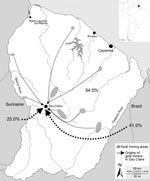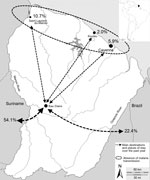Volume 22, Number 5—May 2016
Dispatch
Malaria Hyperendemicity and Risk for Artemisinin Resistance among Illegal Gold Miners, French Guiana
Abstract
To assess the prevalence of malaria among illegal gold miners in the French Guiana rainforest, we screened 205 miners during May–June 2014. Malaria prevalence was 48.3%; 48.5% of cases were asymptomatic. Patients reported self-medication with artemisinin-based combination therapy. Risk for emergence and spread of artemisinin resistance among gold miners in the rainforest is high.
Malaria control programs on the Guiana Shield, a region of South America, are challenged by migrant populations looking for gold. Since 2008, the “Harpie” operation to control and reduce illegal gold mining activities has been conducted by French Armed Forces in French Guiana. Military deployments at illegal gold mining sites have resulted in several outbreaks and increased incidence of malaria in French forces (1–4), which suggests high transmission levels in those areas. Illegal gold mining sites are isolated places in the rainforest, far from health posts. The miners are usually hidden in the forest to avoid police controls, and they live in unsanitary conditions.
Although formal health monitoring is not carried out in these communities, the effects of infectious diseases are of concern. In 2013, a group of 34 illegal gold miners with severe diarrheic and respiratory symptoms were evacuated by plane from a health post to the reference regional hospital in Cayenne. The outbreak was attributed to co-infection with several parasitic, bacterial, or viral agents: seasonal influenza A(H1N1)pdm09, Shigella flexnieri, Necator americanus, Leishmania spp., Streptococcus pneumoniae, and Plasmodium vivax (5). All patients came from the illegal gold mining site of Eau Claire (3°36′00′′N, 53°34′60′′W) (Figure 1). Given these problems, French health authorities decided to provide primary medical care in the field and also to assess the sanitary situation in Eau Claire. We describe the results of the cross-sectional study conducted to assess the epidemiologic situation of malaria.
Because of violence and insecure conditions at illegal mining sites, French military health services conducted the mission. Twelve soldiers and military policemen accompanied the medical team to ensure their protection but also that of the miners’ community. A primary care clinic and laboratory were set up under tents at the Eau Claire gold mining camp from May 28, 2014, through June 6, 2014. Active malaria screening was offered to every person who sought care for any reason.
Diagnostic tests associating the malaria rapid diagnosis test (RDT) (SD Bioline Malaria Ag Pf/Pan; Standard Diagnostics, Inc., Giheung-gu, South Korea) and thin blood films were performed in the field. Patients who had positive results of an RDT, thin blood film, or both received treatment.
Data were collected by physicians concerning each person’s recent medical history, protection measures against mosquito bites, use of medications, and recent travel inside or outside of French Guiana. Patient anonymity was stringently respected; every patient was issued a unique identification number. Only verbal consent could be obtained to avoid references that might reveal the identity of undocumented persons engaged in illegal activities.
Dried blood spots were obtained on filter paper by fingerstick and packaged in individual plastic bags with a desiccant until processing. Plasmodium DNA was extracted subsequently and tested with a nested PCR targeting P. falciparum and P. vivax 18S rRNA genes, according to the method of Snounou et al. (6). The propeller domain of pfK13 gene was sequenced in P. falciparum isolates (7).
We defined Plasmodium infection as a positive RDT, thin blood film, or PCR result. Symptomatic Plasmodium infection was defined as a positive test result and fever (history of fever in preceding 24 hours and/or documented temperature >38°C during medical examination) and/or >2 of the following: nausea, vomiting, diarrhea, abdominal pain, anorexia, headache, or jaundice. Other Plasmodium infections were classified as asymptomatic.
Overall, 205 persons freely sought medical care and accepted malaria screening. The sex ratio was 2.0 (137 [66.8%] men; 68 [33.2%] women). Median age was 39 years (interquartile range [IQR] 32–46 years; range 20–63 years). The workers had been gold panning for a median time of 7 years (IQR 3–14 years; range 1 month–44 years) and on illegal gold mining sites in French Guiana for a median time of 4 years (IQR 1–8 years; range 1 month–25 years). Most (97.6%, 200) patients came from Brazil, 4 (2.0%) came from Suriname, and 1 (0.5%) came from Guyana. Before their arrival at Eau Claire, patients had lived in Brazil (41.0%, 84), Suriname (24.9%, 51), or at another illegal gold mining site (19/69 [33.7%] different sites throughout inland French Guiana and 1 unknown site) (Figure 1). During the previous year, 66.0% (135/205) persons had traveled to >1 area outside Eau Claire: 54.1% (111/205) to Suriname (among those, 60.0% had traveled there >2 times); 22.4% (46/205) to Brazil; and 18.5% (38/205) to the main cities in the malaria-free area along the French Guiana coast (Figure 2).
Of the 205 patients, 156 (76.1%) reported >1 fever episode and 131 (63.9%) reported several (2–>4) episodes; 121 (59.0%) reported >1 malaria episode and 93 (45.4%) several episodes (Table 1). Self-medication with antimalarial drugs was reported by 120 (58.5%) patients, of whom 118 (98.3%) had reported malaria episodes in the past year. Artemisinin-based combination therapies (ACTs) were mainly used: dihydroartemisinin/piperaquine/trimethoprim (Artecom; Chongqing Tonghe Pharmaceutical Co. Mingshan Town, China) by 79 (63.7%) and artemether-lumefantrine (Coartem; Novartis Pharmaceuticals Corp. Basel, Switzerland) by 32 (26.7%). Chloroquine was also used alone or with ACTs by 13 (10.8%) patients. The medication schedules used were not clearly identified, but 53 (44.2%) patients took drugs for 1 or 2 days only. Nets were used by 37 (18.0%) and mosquito repellents by 41 (20.5%) of the 205 patients.
The overall prevalence of malaria infection was 48.3% (99/205). P. falciparum and P. vivax single infections accounted for 44.4% (44/99) and 29.3% (29/99) cases, respectively, and mixed infection with P. falciparum and P. vivax for 26.3% (26/99) (Table 2). RDTs, thin blood films, and PCR were positive for 40.4% (40/99), 32.3% (32/99), and 97.0% (96/99) of patients classified as positive for malaria, respectively. Asymptomatic infections accounted for 48.5% (48/99) of cases. Low parasitemia levels were systematically observed. Only 1 person had a parsitemia level >1%, and no differences in level were found between symptomatic and asymptomatic infections. The propeller region of the pfK13 gene was successfully sequenced in 26 P. falciparum isolates without any mutation detected.
During the 10 days of field work, almost all inhabitants of the gold mining site sought medical care. The high prevalence of malaria and asymptomatic Plasmodium infections observed confirms that malaria is hyperendemic there (8). Because of the mobility of gold miners within French Guiana, malaria also could be highly prevalent among persons at other illegal gold mining sites where competent vectors exist (3). This hypothesis is strengthened by the recurrent malaria outbreaks experienced by French forces involved in operations to control illegal gold mining, particularly in the center of the region (3).
Systematic self-medication by patients using ACTs without following a full course of treatment is a serious risk for emergence of resistance to artemisinin and associated drugs (9). The high price of ACTs in the field (2 g gold) was the primary reason patients gave for not completing treatments. The mobility of gold miners raises 2 issues: the reintroduction of the disease in malaria-free areas (10) and the spread of antimalarial drug resistance if the disease emerges (11). In 2013, parasite persistence on day 3 after treatment with Coartem was described in Suriname, and most participants in that study had worked in gold mines in French Guiana (12,13). In Guyana, pfK13 C580Y mutants obtained from samples in 2010 were recently reported (14). These results may be viewed as ominous. Collaboration between countries of the Guiana Shield to control malaria among mobile populations is urgently needed (15).
Acknowledgments
We thank all military personnel from French Forces and French military health services who contributed to the study.
Dr. Pommier de Santi is a military physician and specialist in public health and epidemiology at the French Military Center for Epidemiology and Public Health, Marseille, France. In recent years, his work has focused on malaria and other tropical diseases affecting the French Armed Forces deployed in French Guiana.
References
- Queyriaux B, Texier G, Ollivier L, Galoisy-Guibal L, Michel R, Meynard JB, Plasmodium vivax malaria among military personnel, French Guiana, 1998–2008. Emerg Infect Dis. 2011;17:1280–2. DOIPubMedGoogle Scholar
- Verret C, Cabianca B, Haus-Cheymol R, Lafille JJ, Loran-Haranqui G, Spiegel A. Malaria outbreak in troops returning from French Guiana. Emerg Infect Dis. 2006;12:1794–5. DOIPubMedGoogle Scholar
- Pommier de Santi V, Dia A, Adde A, Hyvert G, Galant J, Mazevet M, Malaria in French Guiana linked to illegal gold mining. Emerg Infect Dis. 2016;22:344–6. DOIPubMedGoogle Scholar
- Michel R, Ollivier L, Meynard JB, Guette C, Migliani R, Boutin JP. Outbreak of malaria among policemen in French Guiana. Mil Med. 2007;172:977–81. DOIPubMedGoogle Scholar
- Mosnier E, Carvalho L, Mahamat A, Chappert J-L, Ledrans M, Ville M, Multiple outbreaks in gold washing camps in the Amazon forest (French Guiana): what are lessons learned to improve access to prevention and care? [in French]. Bull Epidemiol Hebd. 2015;11:181–9.
- Snounou G, Viriyakosol S, Zhu XP, Jarra W, Pinheiro L, do Rosario VE, High sensitivity of detection of human malaria parasites by the use of nested polymerase chain reaction. Mol Biochem Parasitol. 1993;61:315–20. DOIPubMedGoogle Scholar
- Ariey F, Witkowski B, Amaratunga C, Beghain J, Langlois AC, Khim N, A molecular marker of artemisinin-resistant Plasmodium falciparum malaria. Nature. 2013;505:50–5. DOIPubMedGoogle Scholar
- Hay SI, Smith DL, Snow RW. Measuring malaria endemicity from intense to interrupted transmission. Lancet Infect Dis. 2008;8:369–78. DOIPubMedGoogle Scholar
- Nacher M, Guerin PJ, Demar-Pierre M, Djossou F, Nosten F, Carme B. Made in Europe: will artemisinin resistance emerge in French Guiana? Malar J. 2013;12:152. DOIPubMedGoogle Scholar
- Cohen JM, Smith DL, Cotter C, Ward A, Yamey G, Sabot OJ, Malaria resurgence: a systematic review and assessment of its causes. Malar J. 2012;11:122. DOIPubMedGoogle Scholar
- MacPherson DW, Gushulak BD, Baine WB, Bala S, Gubbins PO, Holtom P, Population mobility, globalization, and antimicrobial drug resistance. Emerg Infect Dis. 2009;15:1727–32 .PubMedGoogle Scholar
- Vreden SG, Jitan JK, Bansie RD, Adhin MR. Evidence of an increased incidence of day 3 parasitaemia in Suriname: an indicator of the emerging resistance of Plasmodium falciparum to artemether. Mem Inst Oswaldo Cruz. 2013;108:968–73. DOIPubMedGoogle Scholar
- Adhin MR, Labadie-Bracho M, Vreden S. Gold mining areas in Suriname: reservoirs of malaria resistance? Infect Drug Resist. 2014;7:111–6.
- Chenet SM, Akinyi Okoth S, Huber CS, Chandrabose J, Lucchi NW, Talundzic E, Independent emergence of the Plasmodium falciparum Kelch propeller domain mutant allele C580Y in Guyana. J Infect Dis. 2015;•••:jiv752. DOIPubMedGoogle Scholar
- Carrara VI, Lwin KM, Phyo AP, Ashley E, Wiladphaingern J, Sriprawat K, Malaria burden and artemisinin resistance in the mobile and migrant population on the Thai–Myanmar border, 1999–2011: an observational study. PLoS Med. 2013;10:e1001398 .PubMedGoogle Scholar
Figures
Tables
Cite This ArticleTable of Contents – Volume 22, Number 5—May 2016
| EID Search Options |
|---|
|
|
|
|
|
|


Please use the form below to submit correspondence to the authors or contact them at the following address:
Sébastien Briolant, Laboratoire de Parasitologie, Institut Pasteur de la Guyane, 23 Avenue Pasteur, BP 6010, 97306 Cayenne CEDEX, French Guiana
Top